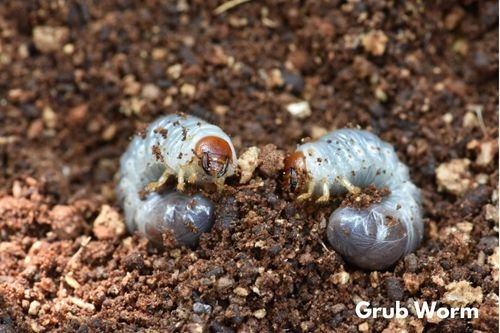
Picture this: you’re planting a beautiful garden, nurturing each seedling with care, only to find that your plants are wilting and the soil is crumbling beneath your feet. That’s where grub worms often come into play. Understanding their habitat preferences can help you protect your plants and create a thriving garden environment. So, grab a cup of coffee, and let’s dig into the world of grub worms and their favorite soils!
What Are Grub Worms?
Grub worms are the larvae of various beetles, with the most common being the Japanese beetle. These little guys typically have a C-shaped appearance and a creamy white color. They live underground, munching on plant roots, which can lead to significant damage to your garden or lawn.
You might be wondering, “Why should I care?” Well, if you’re looking to maintain a healthy garden, knowing about grub worms can help you recognize problems early. When left unchecked, these larvae can become a real nuisance, causing brown patches on your lawn or stunted growth in your plants.
In short, understanding grub worms isn’t just for gardeners; it’s for anyone who appreciates a healthy yard. So, let’s explore where they prefer to set up camp.
Grub Worms and Sandy Soil
Sandy soil is often loose, airy, and well-draining. This can make it feel like a beautiful beach, but it might not be the best home for grub worms. These larvae tend to thrive in moisture-rich environments, and sandy soil can dry out quickly.
Here’s the thing: while sandy soil allows for good drainage, it often lacks the nutrients and organic matter that grub worms need to grow. If the soil is too dry, grub worms may struggle to survive. However, if your sandy soil has been amended with organic matter—like compost—it might just create a more hospitable environment for them.
If you’re dealing with grub worms in sandy soil, you may see them moving deeper into the ground where it’s cooler and moister. So, if you’re gardening in a sandy area, make sure to monitor moisture levels closely.
Benefits of Sandy Soil
Sandy soil does have its perks, though. It’s easy to work with and warms up quickly in the spring, which can be great for early planting. Here’s a quick rundown of the benefits:
- Excellent drainage
- Faster warming in cooler months
- Easy to till and amend
But remember, you’ll need to keep an eye on moisture levels and enrich it regularly. If you’re facing grub worms in sandy soil, consider what’s happening beneath the surface.
Grub Worms and Clay Soil
On the flip side, clay soil is dense, compact, and can hold onto moisture like a sponge. This may sound appealing, but it can create a tough environment for your garden. Grub worms actually thrive in clay soil due to its moisture-retaining qualities.
Let me explain: since clay soil doesn’t drain as well as sandy soil, it often stays damp. This means grub worms have the perfect conditions to munch away at your plant roots. A lush environment with plenty of moisture is their playground!
It’s crucial to note that clay soil can also become waterlogged, which might lead to other issues for your plants. If grub worms are present in clay soil, they might even compound existing problems.
Challenges of Clay Soil
While clay soil can be ideal for grub worms, it presents some challenges for gardeners:
- Heavy and hard to work with
- Water retention can lead to rot
- Soil compaction can hinder root growth
If your garden has clay soil, it’s a good idea to work with it. You might consider amending it with organic matter to boost nutrient levels and improve drainage.
Identifying Grub Infestations
So, how do you know if you have a grub problem? Here are a few signs to look for:
- Brown patches on lawns
- Wilting and stunted growth in plants
- Presence of beetles flying around your garden
If you suspect grubs, you can perform a simple check: dig up a small patch of soil and take a look. If you see C-shaped larvae, it’s time to take action.
Preventing Grub Worms
Prevention is often easier than dealing with an infestation later on. Here are some effective strategies:
- Maintain healthy soil: Enrich both sandy and clay soils with organic matter.
- Water correctly: Avoid overwatering, especially in clay soil, to reduce inviting conditions for grubs.
- Encourage beneficial insects: Some insects, like nematodes, can help keep grub populations in check.
You might also consider planting grass or plants that naturally repel grubs. These can be great companions in your garden to help balance the ecosystem.
What To Do If You Have Grubs
If you’ve discovered grub worms in your soil, you don’t have to panic. There are steps you can take to manage them:
- Use nematodes: These tiny, beneficial worms can help control grub populations.
- Apply organic pesticides: Look for products specifically designed for grubs, ensuring they’re safe for your plants.
- Practice good lawn care: Regular mowing, watering, and fertilizing can keep your lawn healthy and less appealing to grubs.
Managing grub worms is all about balance. While they may be a nuisance, healthy soil and strong plants can withstand their munching.
Final Thoughts
Understanding whether grub worms thrive in sandy or clay soil can be a game changer for your gardening efforts. While sandy soils may not be ideal due to their quick drying tendencies, clay soils provide the perfect breeding ground for these little pests.
By keeping an eye on soil health, moisture, and implementing preventative measures, you can protect your garden from grub worm invasions. Remember, every garden has its challenges, but with a bit of knowledge and patience, you can cultivate a thriving green space. Happy gardening!
